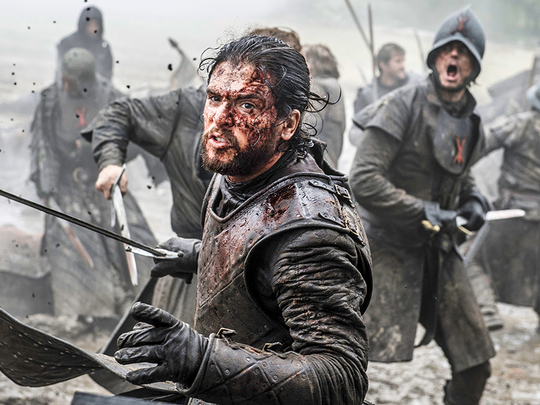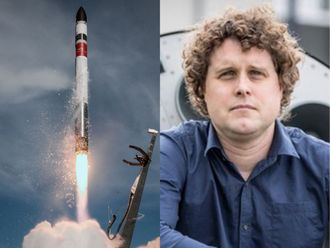
How you watch “Game of Thrones” and CNN is about to have its day in court.
The US Justice Department’s bid to block AT&T’s $85 billion (Dh312 billion) merger with Time Warner is set to head to trial, in one of the most anticipated antitrust battles in years. The deal, if approved, would create a media giant that combines AT&T’s mobile and satellite distribution networks with Time Warner’s huge collection of popular movies and television offerings, including “Game of Thrones” on HBO, news on CNN and college and professional basketball on TNT.
The central question of the trial: Would that combination hurt consumers or help them? How the judge rules in the case has the potential to shape the fast-changing business of video, as consumers increasingly turn to streaming services instead of traditional cable TV. AT&T, a nationwide satellite TV and wireless provider, argues that pairing up with a major content company is necessary to compete against the reach and resources of tech giants like Netflix and Amazon.
But the Justice Department says the deal would hurt upstart streaming services and lead to higher prices for consumers. The decision will frame the competition among Silicon Valley, Hollywood and Madison Avenue, while also establishing what kinds of corporate mergers — in the media industry and beyond — will be permitted in the years to come.
“This court case is so important it is hard to know where to start,” said Amy Yong, a research analyst at the investment firm Macquarie. “This case is at the heart of what we do in our everyday lives.”
The Justice Department’s move to block the deal in November took Wall Street and the entertainment industry by surprise. Many executives and lawyers thought President Donald Trump’s administration would usher in a hands-off approach to antitrust enforcement, despite Trump’s criticism of the deal on the campaign trail.
Instead, the Justice Department, under its antitrust chief Makan Delrahim, moved aggressively, demanding the sale of major parts of the businesses before a deal could go through. AT&T responded by suggesting that Delrahim’s decision was politically motivated and not based on established antitrust law. In recent weeks, though, the judge overseeing the case, Richard Leon of US District Court of the District of Columbia, has rejected moves by AT&T to inject politics into the arguments.
Unless the two sides settle — and there have been no signs of that happening — the trial is expected to showcase two starkly different visions of the US’s video future.
Drama is also in the cards: Executives from AT&T and Time Warner, as well as competing cable, satellite, tech and media firms, are expected to take the stand — and possibly reveal details about the inner workings of the industry. The Justice Department argues that the merged company’s combination of distribution and content would give it too much leverage in negotiations with the rest of the industry.
It also says that the new company would demand higher licensing fees from other cable and satellite firms for what the government calls “must-watch” programming. Those higher charges would immediately trickle down to consumers at an estimated cost of 45 cents a month, or a combined $436 million annually for cable and satellite subscribers, the agency said.
The government’s case will be led by Craig Conrath, a plain-spoken and longtime litigator who has worked on merger cases for several administrations. He is expected to argue that if the merger is approved, AT&T and Comcast, a corporation that owns distribution and programming — the same combination that AT&T is seeking — would have the incentive to raise prices for access to their shows.
That would hurt other cable companies and online streaming businesses. Leon oversaw the final approval of Comcast’s merger with NBCUniversal in 2011, the deal that added programming to Comcast’s holdings.
“Either important video content will be available through a competitive market to all distributors, including up-and-coming innovators,” the Justice Department said in pretrial filings. “Or it will likely only be available through vertically integrated, well-funded silos.”
AT&T scoffs at the government’s predictions of price increases. And even if the analysis is accurate, the company has said, it would amount to the price of a fancy cup of coffee for each consumer. Contrary to the government’s theory that it would withhold content, AT&T says it wants to make sure its shows and movies are as widely distributed as possible.
Leading AT&T’s defence is Daniel Petrocelli, a Los Angeles-based lawyer with a long track record in high-profile cases but not someone who is considered an antitrust expert. Petrocelli is expected to argue that the government is missing the bigger picture. AT&T says Silicon Valley companies like Netflix, Amazon, and Google have disrupted the entertainment industry by spending billions of dollars a year on original content and pushing the programming through their own distribution systems.
Facebook and Google dominate the market for advertisements that run with those videos. AT&T argues that a merger with Time Warner would add a new competitor against those giants, instead of reducing competition. AT&T will also promise to work out any contract disputes with cable and satellite companies through a third-party arbitrator, he is expected to argue.
“The new video revolution is defined by the spectacular rise of Netflix, Amazon, Google and other vertically integrated, direct-to-consumer technology companies,” AT&T said in its pretrial brief.
The merger is opposed by several lawmakers and many consumer groups. Google, Facebook and Netflix, though mighty, don’t own the pipes that connect people to the internet, they say. Streaming competition is the “best hope consumers have, but network operators will kill that competition if they are not stopped,” said Mark Cooper, the director of research at the Consumer Federation of America.
--
Many Wall Street analysts, however, say the government’s intervention in the deal will eventually harm consumers, because it will limit true competitors to the big tech companies. “The government is about three years behind reality and is defining the marketplace as it was about three years ago,” said Laura Martin, an analyst at Needham & Co. AT&T had asked for detailed communications logs between the White House and Justice Department staff members, including Delrahim, a former Trump White House lawyer. Leon rejected those demands, and AT&T ultimately decided to exclude its concerns of potential presidential interference — which it described as “selective enforcement” — from the case. But even without arguments of political interference entering the trial, many on Wall Street will be looking for clues about the kinds of corporate deals that will pass muster during the Trump administration. The decision to block a merger between companies that don’t directly compete is rare. Delrahim has said that one of the common regulatory remedies to prevent anti-competitive behaviour in such deals — getting companies to promise they’ll be on their best behaviour — is not effective. That view may ripple across merger and acquisition plans in other sectors, including the drugstore chain CVS’s $69 billion bid for the health insurance provider Aetna — as well as proposed media deals like Disney’s acquisition of Fox and Sinclair Broadcasting’s purchase of Tribune Media. Wall Street analysts expect the results of the trial will determine if more telecom and entertainment companies will pursue ambitious vertical mergers. “This could direct the future path of the industry,” said Steven Salop, a professor of economics and law at Georgetown University Law School. “If it is permitted, vertical integration will continue.”
- New York Times News Service












